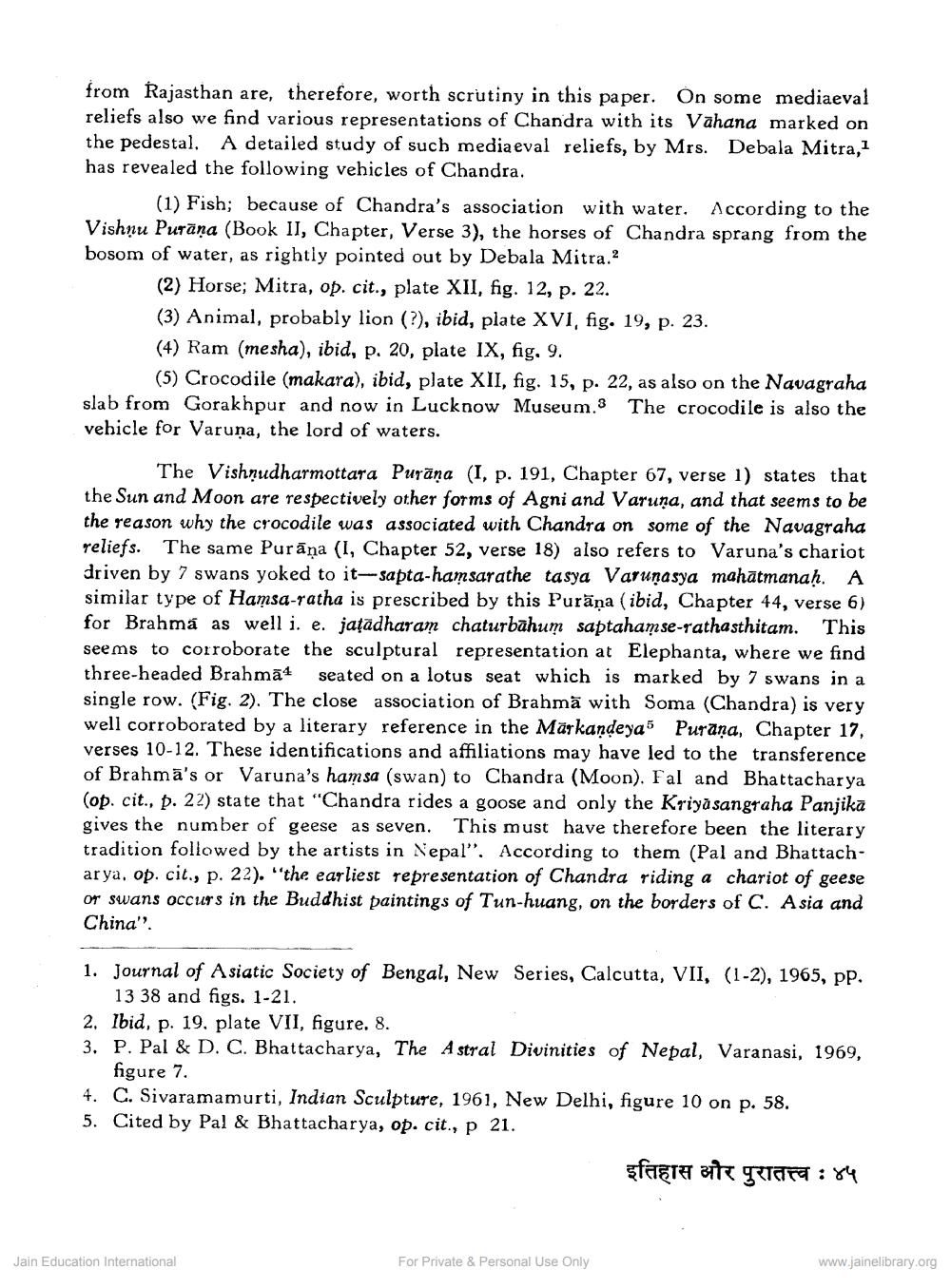Book Title: Chandra Images from Rajasthan Author(s): R C Agarwala Publisher: Z_Agarchand_Nahta_Abhinandan_Granth_Part_2_012043.pdf View full book textPage 6
________________ from Rajasthan are, therefore, worth scrutiny in this paper. On some mediaeval reliefs also we find various representations of Chandra with its Vahana marked on the pedestal. A detailed study of such mediaeval reliefs, by Mrs. Debala Mitra, has revealed the following vehicles of Chandra. (1) Fish; because of Chandra's association with water. According to the Vishnu Purāna (Book II, Chapter, Verse 3), the horses of Chandra sprang from the bosom of water, as rightly pointed out by Debala Mitra.? (2) Horse; Mitra, op. cit., plate XII, fig. 12, p. 22. (3) Animal, probably lion (?), ibid, plate XVI, fig. 19, p. 23. (4) Ram (mesha), ibid, p. 20, plate IX, fig. 9. (5) Crocodile (makara), ibid, plate XII, fig. 15, p. 22, as also on the Navagraha slab from Gorakhpur and now in Lucknow Museum.3 The crocodile is also the vehicle for Varuna, the lord of waters. The Vishnudharmottara Purana (I, p. 191, Chapter 67, verse 1) states that the Sun and Moon are respectively other forms of Agni and Varuna, and that seems to be the reason why the crocodile was associated with Chandra on some of the Navagraha reliefs. The same Purāņa (I, Chapter 52, verse 18) also refers to Varuna's chariot driven by 7 swans yoked to it-sapta-hamsarathe tasya Varunasya mahātmanaḥ. A similar type of Hamsa-ratha is prescribed by this Purāņa (ibid, Chapter 44, verse 6) for Brahmá as well i. e. jațādharam chaturbahum saptahamse-rathasthitam. This seems to corroborate the sculptural representation at Elephanta, where we find three-headed Brahmā? seated on a lotus seat which is marked by 7 swans in a single row. (Fig. 2). The close association of Brahmā with Soma (Chandra) is very well corroborated by a literary reference in the Märkandeya5 Purana, Chapter 17, verses 10-12. These identifications and affiliations may have led to the transference of Brahmā's or Varuna's hamsa (swan) to Chandra (Moon). Fal and Bhattacharya (op. cit., p. 22) state that "Chandra rides a goose and only the Kriyasangraha Panjikā gives the number of geese as seven. This must have therefore been the literary tradition followed by the artists in Nepal”. According to them (Pal and Bhattacharya, op. cit., p. 22). "the earliest representation of Chandra riding a chariot of geese or swans occurs in the Buddhist paintings of Tun-huang, on the borders of C. Asia and China". 1. Journal of Asiatic Society of Bengal, New Series, Calcutta, VII, (1-2), 1965, pp. 13 38 and figs. 1-21. 2. Ibid, p. 19. plate VII, figure. 8. 3. P. Pal & D. C. Bhattacharya, The Astral Divinities of Nepal, Varanasi, 1969, figure 7. 4. C. Sivaramamurti, Indian Sculpture, 1961, New Delhi, figure 10 on p. 58. 5. Cited by Pal & Bhattacharya, op. cit., p 21. इतिहास और पुरातत्त्व : ४५ Jain Education International For Private & Personal Use Only www.jainelibrary.orgPage Navigation
1 ... 4 5 6 7 8 9 10 11 12 13 14 15 16 17 18 19 20 21
